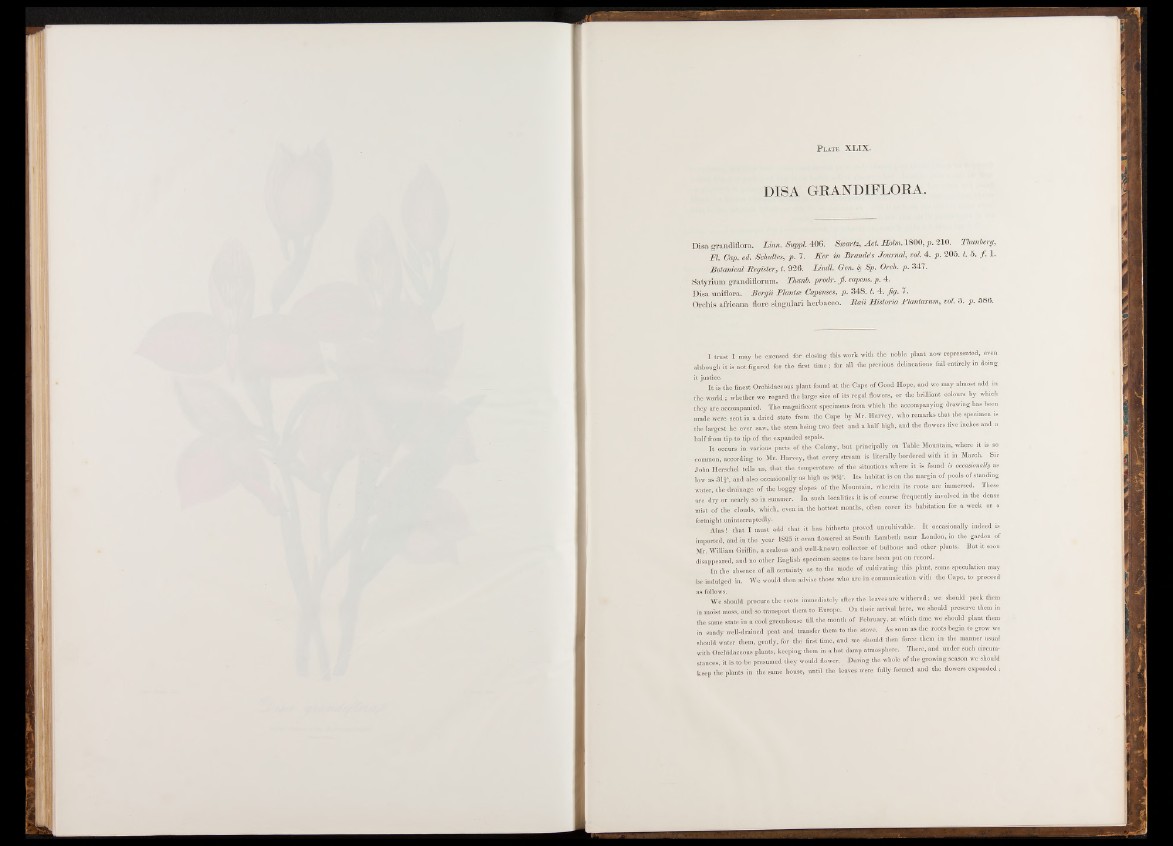
P late XLIX.
DISA GRANDIFLORA.
Disa grandiflora. Linn. Suppl. 406. Swartz, A ct. Holm. 1800, p. 210. Thmberg,
FI. Cap. ed. Schultes, p. 7. Fier in Brandds Journal, vol. 4. p . 205. t. 5. ƒ. 1.
Botanical Register, t. 926. IArOl. Gen. $ Sp- Orch. p. 347.
Satyrium grandiflorom. Thunb. prodr. fi. capens. p . 4.
Disa uniflora. Bergii P lanta Capenses, p . 348. t. 4. jig. 7.
Orchis africain! flore singulari herbaceo. F aii TListaria Flantarum, vol. 3. p. 586.
I trust I may be excused for closing this work with the noble plant now represented, even
although it is not figured for the first time ; for all the previous delineations fail entirely in doing
It is the finest Orchidaceous plant found at the Cape of Good Hope, and we may almost add in
the world ; whether we r e g a rd the large she of its regal flowers, or the brilliant colours by which
they are accompanied. The magnificent specimens from which the accompanying drawing has been
made were sent in a dried state from the Cape by Mr. flarvcv, Who remarks that the specimen is
the largest ho ever saw, the stem being two feet and a half high, and the flowers five inches and a
half from tip to tip of the expanded sepals.
It occurs in various parts of the Colony, but principally on Table Mountain, where it is so
common, according to Mr. Harvey, that every stream is literally bordered with it in March. Sir
John Herschel tells us, that the temperature of the situations where it is found is occasionally as
low as m ° , and also occasionally as high as 96i°- Its habitat is on the margin of pools of standing-
water, the drainage of the boggy slopes of the Mountain, wherein its roots are immersed. These
are dry ’or nearly so in summer. In such localities it is of course frequently involved m the dense
mist, of the clouds, which, even in the hottest months, often coyer its habitation for a week or a
fortnight uninterruptedly.
Alas! that I must add that it has hitherto proved uneultivable. It occasionally indeed is
imported, and in the year 1825 it even flowered at South Lambeth near London, in the garden of
Mr. William Griffin, a zealous and well-known collector of bulbous and otiiUr plants. But it soon
disappeared, and no other English specimen seems to' have been put on record.
In the absence of all certainty os to the mode of cultivating this plant, some speculation may
be indulged in. We would then advise those who are in communication with the Cape, to proceed
as follows.
We should procure the roots immediately after the leaves are withered; we should pack them
in moist moss, aid so transport them to Europe. On their arrival here, we should preserve them in
the same state in a cool greenhouse till the month of February, at which time we should plant them
in sandy well-drained peat and transfer them to the stove; As soon ns the roots begin to grow we
should water them, gently, for the first time, and wc should then force them in the manner usual
with Orchidaceous plants, keeping them in a hot damp atmosphere. There, and under such circum-1
stances, it is to be presumed they would flower. During the whole of the growing season we should
keep the plants in the same house, until1 the leaves Were, fully formed and the flowers expanded ;